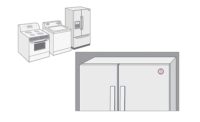Pressure-sensitive adhesives (PSAs) have long been an option for parts assembly in a wide variety of applications.
In fact, PSAs often meet or exceed the performance capabilities of other bonding and fastening methods, such as screws. They can successfully bond foam, plastic and metal parts to create lasting permanent bonds, or they can simply act as assembly aids. Formulated for superior assembly-related performance characteristics, PSAs can tackle everything from high-performance, long-term applications to reliable, low-cost, short-term applications.
PSAs lower costs, enhance production capabilities, improve speed and efficiency of assembly operations, and increase productivity in complex assembly processes. Unlike other assembly methods, PSAs eliminate time-consuming procedures and cumbersome equipment. For example, with PSAs, there is no need to drill or machine parts, as is often required with mechanical fasteners.
PSAs are also easy to handle. In comparison, other bonding methods typically require the handling, mixing or disposing of liquid chemicals. However, with PSAs, chemicals are eliminated. Additionally, PSAs can be placed cleanly and accurately by hand or by heat-assisted or cold-roll lamination processes. PSAs are known for their smooth integration into automated assembly processes, and they have a track record for maintaining stability and integrity during processing.
Thanks to benefits like these, converters and OEMs that use PSAs for parts assembly applications have the ability to create products with slimmer profiles, complex die cuts, diverse shapes, lighter overall weight and greater long-term reliability. If desired, PSAs can also be used in conjunction with mechanical fasteners and other traditional fastening methods.
PSAs for Assembly
In parts assembly applications, PSAs are generally one of two types—rubber-based or acrylic-based. Each has advantages and disadvantages.
Combining natural or synthetic rubber with tackifying resins, antioxidants, oils and other ingredients, rubber-based PSAs create excellent bonds. They are known for their high level of adhesion to a wide variety of substrates and face-stocks, as well as their ability for easy coating. They also adhere well to several hard-to-bond, low-energy surfaces.
However, rubber-based adhesives are often heat-sensitive and are less effective in applications that require exposure to high temperatures. Additionally, if they have prolonged exposure to ultraviolet (UV) rays or certain chemicals, oxidation can affect their performance, causing rubber-based adhesives to darken and lose tack.
Acrylic-based PSAs are formulated by reacting and cross-linking monomers to create strong, customized polymers with the properties desired for an application. Acrylic-based adhesives are durable; possess color stability and clarity; and bond well to polar surfaces like metal or glass.
Additionally, they offer long-term endurance and environmental resistance properties not often seen with rubber-based PSAs, including excellent temperature, UV, chemical and oxidation resistance.
Of course, both rubber and acrylic adhesives can be delivered in varying performance grades for customized functionality. Some adhesives are designed for less holding power and feature a lighter adhesive coat weight for shorter-term applications. Others are more advanced, delivering strong bonds at higher coat weights for longer-term applications.
PSA performance characteristics are determined by the following test methods:
- Peel adhesion: This test measures the force required to remove a PSA from a substrate at a controlled angle. The strength of the bond is determined by the material’s surface energy and the chemical composition of the adhesive.
- Quick tack: These are the properties that allow a PSA to adhere to a surface under very light pressure. It is determined by how quickly the adhesive can “wet out,” or flow into the surface.
- Shear adhesion and cohesion: This test measures the internal strength of the adhesive and its ability to resist splitting when external shear forces are applied in the same plane as the face or the carrier. For assembly applications that need to hold a heavy load or weight, for example, having a high shear is important.
As indicated by the various test methods, the surface to which the adhesive is being applied is an important factor in a PSA’s success. Rough or textured surfaces, for example, can create adhesion challenges. Heavier weight coats tend to perform better on such surfaces. A softer adhesive will also help, since it has better flow characteristics.
Similarly, surface energy can affect a PSA’s ability to wet the substrate. For example, surfaces that have a high surface energy will allow the adhesive to flow into the surface faster and create a stronger initial bond.
Surface energy is measured in dynes per centimeter. High-surface energy materials—such as copper, aluminum, glass and stainless steel—have a surface energy of 150 to 1,100 dynes per centimeter. Medium-surface energy materials—such as nylon, polyester and phenolic—have a surface energy of 42 to 50 dynes per centimeter. Low-surface energy materials—such as polyethylene, polypropylene and Teflon—have a surface energy of less than 37 dynes per centimeter.
To maximize adhesive contact, engineers should make sure that the substrate is dry and free of contaminants. Moisture, grease, silicone and oils can negatively affect the performance of PSAs.
Versatility in Assembly
While surface texture and energy need to be evaluated for every application, PSAs can be used with numerous substrates. PSAs bond securely and immediately to a wide range of surfaces, including wood, metal, glass and even low-surface-energy plastics.
For example, in automotive and transportation equipment assembly, PSAs can be found from bumper to bumper. With the increased demand for lighter, more fuel-efficient vehicles, PSAs are replacing rivets and other mechanical fasteners, which add weight to a vehicle. PSAs often replace mechanical fasteners and screws in applications such as wire tacking, cable wrapping, anti-lock brake systems, headlamps, under-the-hood components, and clutch assemblies. PSAs are also used to bond weather-stripping and other vehicle interior components, such as dashboards, glass, mirrors, fabric and carpet. In addition to bonding, PSAs can also provide moisture barriers, noise dampening and vibration reduction.
Other common assembly applications for PSAs include:
- Assembly aids to temporarily join two parts of a larger object before fully assembling them. These applications typically require less holding power, a lighter weight adhesive coat and less adhesion time, which can be found in low-cost rubber-based PSAs.
- Specialized applications like HVAC systems, open-cell pipe insulation closures, or fiberglass pipe insulation closures. These require an aggressive, high-performance rubber-based adhesive that will deliver strong bonds for rough, irregular and porous surfaces.
- Window setting blocks. These applications require an adhesive such as a cost-effective acrylic PSA that will stick firmly to windows.
- Paneling and kick plate materials used in commercial building. These applications often need to be secured with an enduring adhesive, such as a middle-of-the-road acrylic PSA that resists tough
- chemicals and maintains a strong bond in temperatures as high as 350 F.
- Nameplates for harsh environments, such as those displayed on lawnmowers and power equipment. Since these products are exposed to severe environmental conditions, the best PSAs for these applications are highly specialized and acrylic-based. They are formulated for the ultimate combination of holding power, heat resistance, and adhesion to extremely low-energy surfaces.
- Exterior decking and flooring. This application also requires a highly specialized acrylic PSA with superior durability and performance for harsh environmental conditions.
- Low surface-energy metals and powder-coated surfaces. These applications, too, demand adhesion from a uniquely engineered acrylic PSA to stick to slick, smooth or textured surfaces and to ensure a lasting bond even with exposure to UV light, heat or chemicals.
No matter your PSA parts assembly application, make sure to check with your PSA supplier to confirm you have the best combination of PSA and substrate. For ultimate success, the PSA should be properly paired with the substrate. For example, if your surface has low surface-energy, you need a PSA designed specifically for low-surface energy applications. The most common reason PSA applications fail is that the wrong PSA was selected for the application and the PSA didn’t fully bond to the surface.
For more information on industrial tapes, visit www.mactac.com/industrialtapes, call 800-328-2619 or email mactac.americas@mactac.com.






